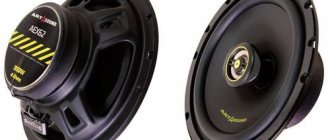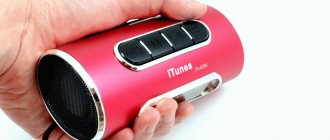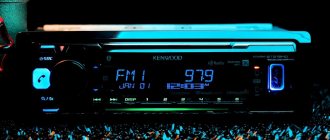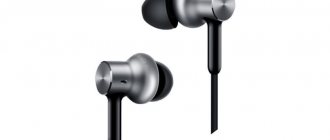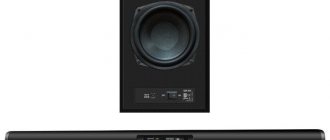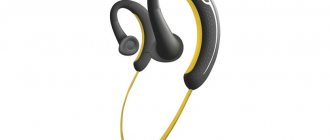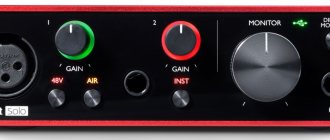It is difficult to imagine the modern world without acoustic systems, represented by a wide range of products that satisfy the most sophisticated needs of true music lovers. But it all started with a banal attempt to hear something at a distance. There was no talk about sound quality, its high, mid or low frequency range in principle, due to complete ignorance.
The physical laws have remained the same, so little has changed since the invention of the telephone by T. Watson and A. G. Bell (1876), although since then the improvement of speakers (electroacoustic transducers) has reached incredible heights.
The first electrodynamic speaker designs used a fabric suspension, the electromagnets were powered by direct current, and the coils were high-resistance. It wasn't until 1925 that General Electric engineers developed and patented an electrodynamic driver that is very similar to modern midrange speakers.
MF (mid-frequency) speakers are very similar to LF speakers - they are like a smaller version of them. The main task of these speakers is to reproduce frequencies in the mid range, from approximately 200 to 8 kHz.
Broadband
The frequency range perceived by the human ear, as already mentioned, ranges from approximately 20 Hz to 20 kHz. The most logical thing would be to have a speaker that can reproduce it in full. And there are such dynamics. They are called broadband.
The question is how well they are able to work at the extreme frequencies of this range. The fact is that in order to effectively reproduce low frequencies, the diffuser of a classic speaker must be quite large. For example, for a frequency of 40 Hz its diameter should be about 30 cm. This is quite simple to implement.
Wideband speaker ScanSpeak 10F/4424G00
But at high frequencies, such a diffuser simply will not be able to “have time” to transmit vibrations over its entire surface. This is why, more often than not, full-range speakers are the result of a compromise.
For high-quality reproduction of the upper part of the frequency range, an additional high-frequency diffuser is often glued into the center of the diffuser of a broadband speaker - a “horn” (cone-viser, “pipe”), which is capable of reproducing “fast” vibrations while the main, large diffuser works much more slowly.
Widebands used in audiophile systems are the subject of serious engineering developments bordering on art. Here, materials with the highest possible parameters and know-how are used, which still make it possible to obtain a full-range driver.
Lii Audio 2PCS Fast-10 Full Range Speaker
The most problematic thing for a full-range speaker is reproducing the extreme frequencies of the audible range. If a broadband speaker is capable of operating in the range of 60–16000 Hz with an unevenness of ± 10 dB, this is already a good result.
At the same time, due to the simplicity of the design and the absence of filters (crossovers), a speaker system with a wideband speaker is capable of demonstrating high sensitivity - from 90–92 dB and higher. This makes speakers with full-range drivers especially popular among fans of tube amplifiers, which, as a rule, have limited power.
In this regard, the voice coils of such broadband speakers have increased resistance. Generally accepted values for all other speakers intended for installation in acoustic systems are from 2 to 8 Ohms.
In addition, it is the broadband speaker that is as close in its parameters as possible to a point sound source - an ideal acoustic object from the point of view of its localization. The direction to the source in this case is determined by the listener as accurately as possible. Such an emitter allows you to create the most accurate stereo stage (sound stage), since there is only one sound source in the stereo channel and it has a minimal area.
On the other hand, the simplest speaker with a broadband speaker is the cheapest solution, but in this case there is no need to talk about full-range playback.
It is clear that if it is difficult to reproduce the entire range with one emitter, it makes sense to divide this range into several frequencies, in each of which a separate speaker will operate. In this case, the tweeter (tweeter) is responsible for the high frequencies.
This speaker must have a diffuser (membrane) of a small area, but quite rigid and as light as possible, because the tweeter emission band, in most cases, is not lower than 1.5 kHz. Among speakers, the dome tweeter is the most widely used. In it, the central body of the diffuser or element, which in a full-size speaker is called a dust cap, occupies almost the entire area of the radiating surface.
Apple HomePod speaker tweeter
The dome tweeter membrane is most often made of fabric with impregnation, which increases its rigidity. Harder materials are also used, the best of which is rightfully considered beryllium.
An important parameter of a tweeter is its own resonance frequency. The developers strive to ensure that it is below its playback band. In this case, the tweeter sounds as accurately as possible. The fact is that at frequencies close to resonance, the amplifier-speaker complex begins to work incorrectly, “goes into overdrive,” and the system becomes poorly controlled.
The result is distortion, and in the frequency region in which our hearing is especially sensitive to it. The solution turned out to be simple: a crossover - a device that limits the frequency range of the tweeter, “cuts off” the frequencies of its own resonance located below the operating range of the tweeter, which, as a rule, starts from 2-3 kHz.
Tweeter with diamond membrane Seas Excel E0100-04
The second requirement for a tweeter is an increased upper limit playback frequency. In the optimal case, it should exceed the upper frequency threshold of the audible range, i.e. be above 20 kHz. It would seem, why go higher if we no longer hear anything at these frequencies?
The upward limit of the frequency range allows the tweeter to reproduce the so-called upper harmonics, creating the most accurate sound of high frequencies. To what limit should a tweeter be able to operate - and opinions are often expressed about values of 40 or even 60 kHz - is a matter of debate.
The above two requirements for tweeter design are mutually exclusive. To reduce resonance, it is necessary to make a membrane of larger size and weight, and to increase the upper limit of the frequency response, vice versa. The output is the maximum ratio of stiffness and mass of the tweeter membrane, for which there is a technological struggle.
Midrange speaker
A speaker that plays midrange frequencies (it is also sometimes called midrench or, more correctly, midrange - this term, from the English midrange speaker, comes from car audio), is usually closest in design to a classic speaker. It is important that this speaker reproduces exactly the frequency range in which the human voice is located and in which our hearing is especially sensitive to distortion.
Example of speaker behavior, measurements taken with a laser interferometer
The Achilles heel of the midrange driver is the effect of the appearance of specific deformations of the diffuser - the so-called bending wave, when the peripheral region of the diffuser does not keep up with the movements of the central zone where the voice coil is attached. That is, different zones of the diffuser (by the way, located, as a rule, in spots, and not concentrically, as would follow from the logic of the process) do not vibrate in phase - some areas lag behind others.
The sound becomes “loose” and inaccurate. This means that the diffuser should be as rigid as possible. If we solve the problem head-on, we will get a really hard diffuser that will weigh so much that it will not be able to sound. Therefore, as in a tweeter and a broadband speaker, the design of the diffuser contains a complex compromise - between rigidity and lightness.
Midrange driver Morel SCM 634 with carbon diffuser
For high-end speakers, the design of the diffusers is the most important point. In exotic versions, midrange drivers (just like tweeters, but much less frequently) receive a beryllium diffuser. But much more often in midrange speakers you can see diffusers made of composite materials based on carbon fiber, fiberglass, Kevlar, wood fiber or classic cellulose.
Scope of application of midrange speakers
The original (English) version of the name of the midrange speakers contains the phrase “midrange speaker” (or midrange) which came from car audio. The midrange driver operates in the most convenient human range, so any distortion is clearly detected by human hearing. The scope of application is unusually wide, since a huge range of human activity is associated with sound.
These include concert acoustics and car audio systems. At home, midrange speakers have proven themselves excellent as active and passive speaker systems. Estrada also uses a wide variety of midrange drivers.
Low frequency driver
A woofer is often also called a woofer. For almost any class of acoustic systems, the woofer is naturally the largest radiator in area. For a low-frequency driver, a fully piston operating mode is preferred, when the diffuser moves back and forth as a single unit.
Here the problem is solved even more radically than in the case of the mid-frequency driver. The diffuser is made as rigid as possible, even by making it heavier. The fact is that at low frequencies our hearing is least sensitive to distortion. And in the case when the amplitude of vibrations is primarily important for the woofer cone, for the sake of rigidity they go for an increase in weight.
24" woofer in Pro Audio Technology subwoofer
The mass of the moving system of many large subwoofer speakers can reach 200 g or more. Diffusers in some cases receive a spatial structure similar to an aircraft wing made of a multilayer composite with the internal cavities filled with light cellular or honeycomb structures.
For audiophile systems, they still try to minimize the mass of the low-frequency driver cone, since trained ears do not like low-frequency distortion, just like everyone else.
Moreover, the oscillation amplitude of the woofers is the largest among all the listed speakers. To do this, they are equipped with a so-called long-stroke (extended) voice coil. The external suspension is made of rubber. All this allows the diffuser to have a very large excursion - this is how the diffuser’s displacement from the central point is called.
18" JBL bass woofer
The “breed” of a low-frequency speaker is especially pronounced in the drivers that are installed in subwoofers. This is a heavy, powerful device with a diameter of 8 to 15 inches (the most common size range in consumer speakers). They have very powerful magnetic systems and, therefore, a considerable total weight. At the same time, in low-frequency drivers operating from powerful semiconductor amplifiers, coils of minimal resistance are often installed - 2 or even 1 ohm.
Pros/cons of midrange speakers
Depending on the design of midrange speakers, there are a number of advantages and disadvantages.
So, in the case of using small midrange speakers (tweeters with soft domes), good damping, smoothing (self-damping), as well as a fairly flat amplitude-frequency response (AFC) can be considered an advantage. Excellent impulse response allows for an open, natural sound without resonance. Disadvantages include dull sound and low power characteristics.
When using metal dome tweeters, you can note the sound of very high resolution, thanks to the flat profiles, in contrast to the soft designs of midrange speakers, which have high distortion and limited power capabilities
If midwoofers and wideband speakers with paper cones are used as mid-frequency speakers, then they have a very smooth frequency response, excellent resolution and detail, as well as smoothing.
Considering the material (paper), which is less rigid than Kevlar or metals, such products have lower volume.
If we rely on the design of the diaphragm (cone-shaped and dome), then we distinguish the following:
- Dome diffusers have less modulation distortion, and their radiation pattern is less dependent on frequency. The products are distinguished by a small range of reproduced frequencies, starting from 800-1000Hz, which causes some inconvenience during settings.
- for cone heads in midrange speakers, it is necessary to provide a given volume of the housing. Otherwise, the optimal diameter of the cone head is considered to be the “golden” median size of 10 cm.
Coaxial Drivers
In a two- or three-way speaker, the tweeter, midrange and woofer are installed separately, that is, they are spaced apart. This is a serious disadvantage. Our hearing, which easily determines the direction of the sound source, can be deceived by the fact that mid frequencies and high frequencies come from almost different points.
The direction to the low-frequency emitter is more difficult to determine, but nevertheless its distance also makes its contribution. As a result, this speaker geometry worsens the perception of stereo image.
Structure of the KEF UniQ coaxial driver
The wideband speaker described above, simply due to the physics of the process, has limitations in both maximum power and frequency range. In addition, for a wideband speaker, high frequency response unevenness is inevitable (above 10–20 dB), which is practically impossible, and there is no point in compensating for it with electronics or acoustic design.
The way out of this situation was a coaxial driver. At first glance, such a combined speaker looks quite simple. In the two-way version, the tweeter is located in the center of the woofer - traditional tweeter sizes are quite suitable for this. But from an engineering point of view, such a configuration greatly complicates the development (calculation) and production of such a system.
Coaxial speaker TAD CST
And this is reflected in its cost. There are options that allow you to simplify the design: for example, placing the tweeter in front of the low-frequency diffuser on a special mount. And yet, it is “full-fledged” coaxial systems that create the most accurate stereo effect. Therefore, at all times, various developers and companies have produced coaxial drivers that were included in their top-end systems.
Types of acoustics for cars
All acoustic systems are divided into two types: component and coaxial. Coaxial devices are simple and easy to install, and are cheaper in cost. Such devices are not difficult to connect and configure. Such systems are classified according to their ranges. Each range has a corresponding speaker. Typically, coaxial equipment consists of one column.
Speakers for cars
Component acoustics are distinguished by a separate arrangement of speakers. When installed correctly, such a system produces excellent sound. The price of component equipment is higher, but the difference in sound quality is colossal. If you don't want to spend the entire set, you can buy the speakers separately. Mid and low frequency speakers cost less than high frequency speakers.
Specialized speakers
Reproducing sound in conditions other than indoors requires the use of speakers that take this specificity into account in their design. Speakers for landscape, mine, and marine applications must withstand high levels of dust that can penetrate the magnetic gap, prolonged solar radiation, high humidity, exposure to sea salt and other negative factors. To achieve this, major changes are made to the design: materials are selected and vulnerable elements are protected.
